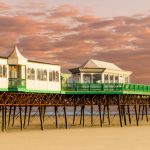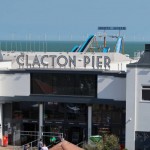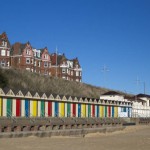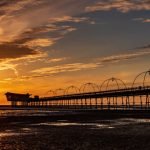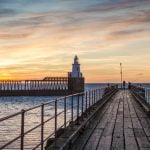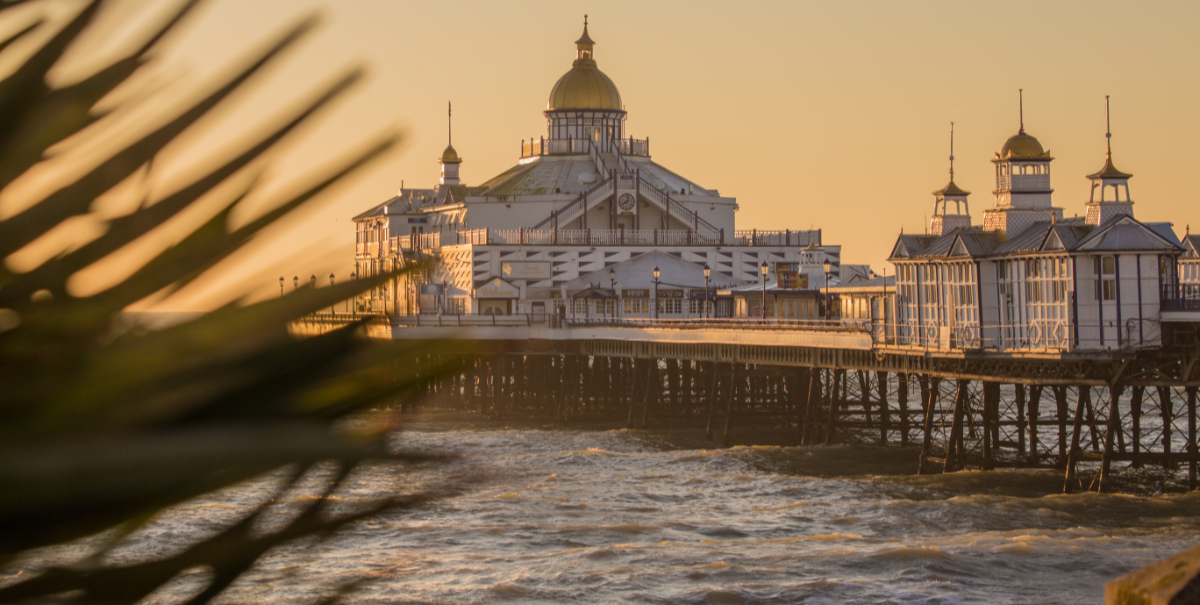
Eastbourne in Under Five Minutes Your go-to guide to the brightest sunny seaside town in East Sussex.
Modern Eastbourne makes its money collecting tourists from London. Situated southerly enough but it can be visited in a day trip from the capital city, Eastbourne has long since made its money by selling fish and chips on the promenade. It is the kind of place that many of us have nostalgic memories of. But Eastbourne is more than just a seaside town.
Among the memories of wrestling seagulls for your dinner and finding shells on the sand beach, Eastbourne has a long history as a respected part of British culture, and not least because of the striking white cliffs that surround it.
Let’s take a look at Eastbourne through the ages and find out how it measures up as a staycation destination for 2021.
The early history of Eastbourne
Eastbourne is old: possibly older than the hills. Stone Age artefacts have been found in and around the town, with a Stone Age flint mine found in the Eastbourne Downs. We didn’t even realise that people in the Stone Age mined for things until we started reading about this place.
There is a bronze age site that was discovered near Shinewater back in 1995. Some sources say that Eastbourne was a large Village for many centuries before it became prominent during industrial times. Other sources maintain that it is always been an attractive place to live, due to the steady influx of fish and tourists.
The Romans certainly thought so, since they buried some of their dead in the area. As well as Roman remains, archaeologists have found evidence of a Roman villa on the waterfront. In 2014, a skeleton was found and the Eastbourne Downland Estate. The Remains were dated 425 AD. This would have been after most of the Romans had already left Britain, towards the end of their presence here. We can only assume that the southern waters and the temperature climate of the South reminded them of home and so some chose to stay on. The Romans intermarried with the natives so it’s possible some didn’t leave.
Shortly after the Romans left, Eastbourne would have been reduced to a small fishing village. Although evidence shows that Romans were here, it doesn’t show any significant structures such as stables or bathhouses. This leads us to believe that the town was already a fishing village when the Romans arrived and that this is what it went back to afterwards. It would have been a nice place to have a country holding by the sea.
Anglo-Saxons lived in the area around the end of the 900s. It is thought that they are responsible for naming Eastbourne. East of the burn, which would have been the name of a small stream in the area. Granted in old English burn was spelt with an ‘e’ on the end… Not quite the same as the Scots word for a stream.
As we know, the Normans invaded in 1066 and King William the Conqueror finally got round to surveying his spoils 20 years later, in 1086. At the time of the survey, there were 88 households living in this seemingly small town. There were two owners listed, one was the Count of Eu.
He owned 5 men’s ploughlands and teams of men to work them. He also owned A fishery, which would have made him a rich man. In 1086 the land was worth 2 pounds and five shillings every year.
The other owner Of Eastbourne in 1086 was Count Robert of Mortain. This Count was exceptionally wealthy and must have had the favour of the King. He owned 28 ploughlands and had 5 teams to work them. He also owned 25 acres of meadows, 16 salt houses, and a mill. The land was worth 43 pounds and 7 shillings. Salt houses would have been especially productive by the sea.
In 1315 the town got its first charter from Bartholomew de Badlesmere. Later, in 1232, it was granted it’s second charter. This charter allowed them to have a weekly market and to hold a fair once a year. In medieval times, fairs gave people the chance to trade, hold festivals, and make connections with surrounding villages. They were important matters and so Eastbourne must have grown in significance to have earned its right to a fair. Many marriages would have taken place here.
Notably, during the 11-12th century King Henry, the First and Edward II both came to visit. The local St Mary’s Church was erected in that same century. Bourne Place was built for the first time as a Manor House at roughly the same time.
That just about sums up medieval Eastbourne, so let’s take a break from the history for now.
Facts and Trivia about Eastbourne
In this section, we like to take some time to appreciate the freshest facts to have emerged from the area. Since Eastbourne history goes all the way back to the Stone Age, we are sure we won’t be disappointed. Here are the Five Minutes Spare favourite fun facts about Eastbourne:
- Eastbourne was one of the worst bombed towns in Sussex during World War II. It is estimated that as many as 4,000 bombs fell on the town during the war. The Nazis used Beachy Head as the landmark for their bombs. Hitler did request that the Grand Hotel be left untouched in case he wanted to stay there after the war.
- Since July 1911, Eastbourne has been renowned as the sunniest place in the UK.
- Eastbourne is one of the biggest staycation destinations in the UK, even before the pandemic. It usually sees roughly 4.9 million visitors every year.
- Several famous films were made here or shot here. Some of these include James Bond films, Pearl Harbour, and even Harry Potter.
- Theresa May was born here, which is a bit of a shame. If we were from Eastbourne, we would want to keep that quiet.
And on that note let’s get back to the history before we get into a political debate. She’s probably very nice, deep down.
Eastbourne in the Industrial Era
By the end of the 16th century, Eastbourne had a population of roughly 1,000 people. Like many small English towns, Eastbourne truly took off during the Industrial Revolution. Unlike most English towns, it wasn’t mills and factories which brought people to Eastbourne, but the seaside.
A dissertation was written in 1752 by Dr Richard Russell, in which he advocated the benefits of bathing in seawater. This led to a myriad of visitors to the closest seaside to London, which just so happened to be Eastbourne. Those visitors spent freely and were encouraged by King George VI and his children who visited in 1780. Throughout the Georgian period, the town of Eastbourne had a steady income from high society guests.
1793 then saw coastal defences added to the town, which were used during the wars. Several Towers were built, and a fortress was constructed which would later be known as Eastbourne Redoubt. It was intended as a barracks and storage facility, but it had cannons. It still stands to this day and makes for a pleasant afternoon out.
By 1851, Eastbourne had grown to 3,500 people. Wish Tower was built in 1804 to add to the defences and act as a lookout post. In 1849 the railway arrived, changing tourism in Eastbourne forever. The Working Man could now afford to come here for a day trip at the weekend. Eastbourne was no longer a rich man’s town. A new wave of tourist arrived… ones that wanted fish and chips and were satisfied with sand between their toes and not much else.
By 1871, it is estimated that 10,000 people lived in Eastbourne, and the addition of both a gas and a water company in the 1850s would have benefited them greatly. The sewers were dug in 1863. The dispensary shortly followed. It would have given out medicine to the poor.
Eastbourne’s famous pier was built in 1872 but has had many refurbishments since. Devonshire Park was added in 1874 with the theatre of the same name opening 10 years later. The town hall was added in 1883 with Hampden Park added in 1902. By this time Eastbourne had 43,000 residents.
Plenty of growth in the 1900s saw the town flourish into what we know it as today. The Tallinn Gardens were opened in 1905, the technical Institute was built in 1904, the Towner art gallery was built in 1924, and St Mary’s Hospital was added in 1930. More museums, retail establishments, eateries, and hotels were opened all throughout the 20th century.
Modern Eastbourne
Of course, the whole country came through two world wars. Since Eastbourne was situated on the southern coast, this put it directly in the firing line for enemy aircraft. They were badly bombed in World War II, with more than 4000 bombs dropped. As we mentioned above, Hitler made Bazaar request that they avoid bombing the Grand Hotel because he thought it looks like a nice place to visit, once he had won the war.
It is estimated that 174 people were killed at home during WWII in Eastbourne. The majority of these deaths happened on Sunday 7th of July in 1940. In 1939, a review had branded the town a safe zone. Nobody thought anyone would bother to bomb a sleepy seaside town. They were grossly mistaken, and this cost lives.
Modern Eastbourne is a bustling hive of market day activity. It attracts a steady stream of tourists – almost 5 million every year. While historically the residents of the town made their money from fishing, the last 400 years have seen this profit collected from the tourism sector instead. What does this mean for Eastbourne? It means that the coronavirus has crippled the economy.
If there is anywhere in Britain that you should go for a staycation this year, this is it. Not only does Eastbourne have plenty of attractions for you to visit, it also seriously needs your cash right now. Do your patriotic duty and pay it a visit soon. It might be the holiday of your dreams, but it will definitely help a few people out.
Famous people from Eastbourne
This wouldn’t be one of the classic 5-minutes spare guides if we didn’t include famous people. So, if you happen to be on a staycation in Eastbourne this year, here are our favourite folk you might meet down at the supermarket:
- Let’s not forget about Theresa May… although we wish we could.
- The actor Peter Childs is from here.
- Metal band the Divided come from Eastbourne.
- Clive Francis was an Eastbourne actor
- BBC Newsreader Jane Hill.
As you can see, there are plenty of famous faces to have come from Eastbourne. Not bad for a large fishing settlement.
Attractions in Eastbourne
And now we arrive at the section that you’ve all been waiting for…. The attractions of Eastbourne. If you are planning on visiting for a holiday, try and do some of the following things while you’re in town…
Historic Sites and Landmarks
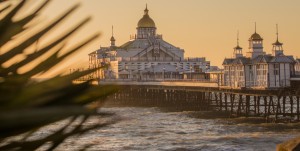
Image: Nigel Wiggins/Shutterstock.com
One of the most instantly recognisable attractions in town is Eastbourne Pier. Built at the tail end of the 1800s, this pier has seen many a drunken shuffle. It is neither the longest nor is it the oldest in the UK, but it is still very much worth a Sunday stroll to get rid of that hangover. It has a few attractions of its own which are well worth a visit.
Next on the list of historic sites and landmarks you should see, is Eastbourne bandstand. Said to be one of the busiest bandstands in England, Eastbourne bandstand is used for the purpose for which it was intended… By which we mean that it is s used to put on concerts and live gigs. If you are in town and want to catch a show, this is where you go to do it.
Another classic landmark in town is the stunning Royal Hippodrome Theatre. This theatre is massive, was built in the 19th century, and features some striking architecture on the inside. It sports wide, high ceilings, with multiple layers of seats for you to choose from. If you happen to be booked in for a show in Eastbourne but it’s not happening on the bandstand, then you are likely to be in this venue, though there are other theatres.
Museums and Galleries
There are some remarkably interesting museums and galleries in town. One of the best places to visit is the Redoubt Fortress and the pavilion. Although not technically a museum, this area is rich with history. It sports unique views of the town from the water and contains all the glamour and charm of an 18th century war building. It still has cannon. Expect to spend an afternoon touring this historic site and imagining what it would have been like when it was manned with soldiers.
Tucked away in behind the Grand Hotel that Hitler adored so much, you will find the Nigel Greaves gallery. This art gallery was setup by local artist Nigel Greaves, but features many other works of fine art. Some of these pieces are by local artists, and some come from further afield. If you want to buy art while on holiday in Eastbourne, this is a good starting point.
On the other hand, if you would like your paintings high-tech and fancy, as opposed to fishing village themed and pretty, you go to the Towner art gallery. The Towner is part art gallery, part fine art museum. In this building you will find regular exhibitions, contemporary artists, and a place to Lose time for an afternoon.
If you are looking for something to do in Eastbourne with children, you may wish to stop in at the story of Eastbourne children’s Museum. This wonderful place details Eastbourne through the ages in a fun and interesting way. Kids love this museum, and it is highly informative for adults too. Several of the exhibits are interactive to encourage learning and fun.
Outdoor Attractions
Beachy Head is one of the top rated attractions in the area. This is the name given to a sandy beach at the headland of the bay. This beautiful beach is backed by the White Cliffs not of Dover, but of Eastbourne. They are beautiful, nonetheless. This is a unique walk with some fascinating geological formations not found elsewhere in the country. If you are mobile and active, tourists recommend this as a firm favourite.
Those who like to walk will want to check out the Birling Gap and the Seven Sisters. The Birling Gap is a pass in the cliffs while the Seven Sisters Are 7 white cliffs in perfect geological formation, that lie beyond the headland of Eastbourne. This is an area of overwhelming beauty, but it does get exceptionally busy in summer and on sunny days.
Who can come to Eastbourne without taking a trip to the Miniature Steam Railway Adventure Park? This place is exactly what it sounds like. It is an outdoor theme park, with the theme being steam railway and steam trains. There is a miniature track which runs through the park, it has its own cafe, and there is even an exhibit regarding the history of the steam train. It is simultaneously nostalgic and wonderful to be able to visit a steam railway in the modern world. This one might not be life-size but that doesn’t take away from the fact that it’s awesome.
Shopping and Retail
There are plenty of shops for you to enjoy both along the promenade and within the town centre of Eastbourne. One of the best malls and town is the beacon and you will find every type of shop contained within it.
Parks and Amenities
Take the kids out to Sharnfold Farm for an afternoon, where they will be able to see CR real farm Works. They have a play area, they have a cafe, and they have plenty of adorable animals for your children to pet. Help your kids learn about nature and learn to love countryside life.
Princes Park is one of the best in the area and features a large lake at its Centre. Take a long walk around the outside of it, enjoy the play areas scattered throughout, let your kids claim some trees, or even feed some ducks. There are seating areas and even picnic areas contained in Princes Park.
Sports and Recreation
Eastbourne have its own football team, they are called Eastbourne borough FC. They routinely train at Langney sports club, with you can go to catch a game.
Since Eastbourne is an English town, it does have its own golf club. Choose from the Eastbourne Downs Golf Club, the Lottbridge Golf Club, or the Royal Eastbourne golf club.
Other notable attractions in Eastbourne
We have just about covered all there is to know about visiting Eastbourne this summer. There are some areas that we have missed, so let’s try to round them up as well. If you’re spending extra time in Eastbourne, try to see the following things:
- Visit the Grand Parade main resort beach, or the Hollywell Retreat beach.
- Take a trip to the Devonshire Park tennis complex and get your game on.
- Go and see the wish Tower, which looks very pretty but was constructed as an observation deck to spy incoming enemies.
- You really shouldn’t miss out the Eastbourne lifeboat Museum while you’re in town.
- Visit the Sovereign Centre Sports Complex and enjoy the pool.
- Or visit the slightly more serious Congress Theatre.
There really is something in this delightful seaside town to suit us all.
How to get to Eastbourne
We are ready to round up but before we do, let recap how you get to this sunny seaside town.
By road
Follow the M26 south out of London.
By rail
Aim for Eastbourne Station on the Southern Railway line.
By air
The nearest airport is London Gatwick.
By sea
The sovereign Harbour Marina connects to the sea.
Got 5 Minutes?
If you have 5-minutes spare and you enjoyed this guide, head on over to our home pages where you will find many others. Search long enough and you just might spot your own hometown.
